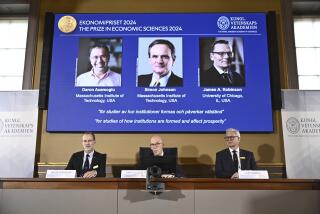Realizing Technology’s Promise for the Economy
Despite reports to the contrary, confidence is growing in U.S. industry, and the economy is probably enjoying greater productivity growth--an essential for rising living standards--than official statistics show.
Those are the conclusions to be drawn from conversations with officials who have great influence on the U.S. economy and from the actions and expectations of leading companies as they look forward to the next big development in technology.
To be sure, there are clouds on the horizon: Research budgets are being cut by government and private industry, and the uneven economic benefits of advancing technology are making many Americans uneasy.
But the fact remains that the spread of rapid and innovative communications and ingenious software into every corner of U.S. industry has quietly added the equivalent of $50 billion a year to the U.S. economy. Times are so good--and stock prices so high--for many U.S. high-tech companies that the challenge is to avoid complacency and push on to develop new products. One of those products is likely to be a digital hand-held computer and cellular phone combined with an Internet access device. It exists now as a concept for which 36 companies--including Compaq Computer, IBM, AT&T;, Dow Chemical, Motorola and Delco Hughes Electronics--along with universities and the Departments of Defense and Commerce formed a cooperative venture last week to help U.S. companies manufacture key components.
The aim of big companies in the cooperative, called the National Electronics Manufacturing Initiative, or NEMI, is to assure U.S. industry a major place in the new technologies and to protect its own supply lines.
Also, it’s an attempt to focus diminishing government research spending and to generate the kind of skilled, well-paying jobs that technological development has always promised.
A tall and complex order, but the NEMI initiative comes at a good time. That’s in marked contrast to seven years ago, when fear was widespread that U.S. industry would lose control over all high-tech industries to Asian producers who had low labor costs or a seemingly superior system for long-term technological development. Sematech, a government-industry partnership, was set up in 1987 as an emergency measure to help U.S. companies hang in there on semiconductor production.
Yet today, the U.S. electronics and computer industries are far ahead of the rest of the world, and the spread of technology through every aspect of American life is awe-inspiring.
What changed? Well, Sematech helped some. But perhaps more important, technologies such as network systems and software that were only emerging in the last decade came to fruition.
And the labor cost issue has shifted. Incomes in Asia have risen--Singapore wages are now close to the U.S. average annual wage of $25,935; Japan’s wages are above that. More important, the $41,720 average annual salary of the 1.8 million Americans who work at 16,000 U.S. electronics companies is not the drawback it may seem. Jobs in the development and manufacture of advanced communications and graphics depend on know-how more than wage levels.
Such jobs demand skills taught at the community college level, says Mary L. Good, undersecretary for technology in the Department of Commerce. “They’re the kind of jobs we want to make more of,” she says, though she notes the irony that government research budgets for civilian purposes are scheduled to be cut from $38 billion today to $23 billion in 2002.
It’s an ironic time in other ways. Official figures show U.S. economic productivity, especially in services, barely rising. Yet experts in the Federal Reserve and elsewhere in government know that the software that allows an assembly worker to turn out cars with zero defects every time or an engineer to send plans for a water system halfway around the world is making the U.S. economy more productive.
It’s also a confusing time, a lot like the late 19th century, when numerous inventions--electricity, the telephone, the first automobiles--came in a bunch. The flourishing of those inventions into new industries and ways of life didn’t come for decades--until the 1920s, when everything took off.
There were disparities of income then too, which led to trouble in the 1930s.
That’s why it’s important to spread the work of technology around U.S. industry, as NEMI proposes. Under the initiative, in which $80 million will be spent on half a dozen projects over two years, major companies will give orders to small manufacturers for development of advanced products, such as the polymeric underfill of electronic chips.
Work in such obscure but critical processes often leads to discoveries of new directions for technology--but it’s hard to know those directions unless you do the work yourself.
“Many parts of cellular phones that were invented here must now be sourced in the Far East,” says Mauro Walker, Motorola’s director of manufacturing and an originator of the NEMI idea.
Seeds must be planted for crops to grow. Today’s $41,000-a-year jobs in electronics come out of research done long ago for defense or the space program or the pioneering work done at the old Bell Laboratories.
Put another way: A lot of the value in today’s sky-high stock market originated in research done 20 years ago. So where is research being done today to produce comparable values tomorrow?
That’s a painful question as government and private industry claim to be saving money by cutting research. “The real effect will be seen 20 years from now when you run out of new ideas,” predicts A. Michael Noll, a professor at USC and former research scientist at Bell Labs.
Michael Milken, the fallen junk-bond financier who undeniably sees through numbers, says the higher earnings being produced by pharmaceutical mergers today result from cutbacks in research for tomorrow.
The true bottom line is that a society that believes in the future makes provision for it. That’s what the companies, universities and agencies that set up NEMI tried to do last week. It’s a start.
More to Read
Inside the business of entertainment
The Wide Shot brings you news, analysis and insights on everything from streaming wars to production — and what it all means for the future.
You may occasionally receive promotional content from the Los Angeles Times.










